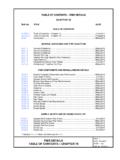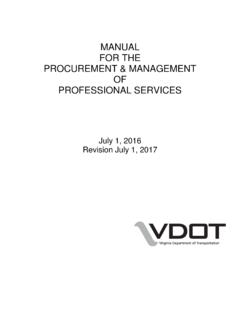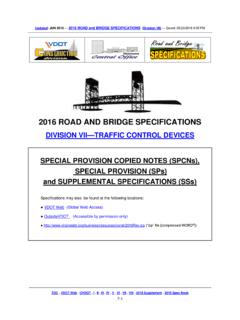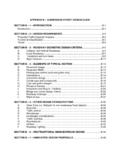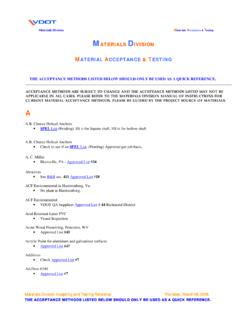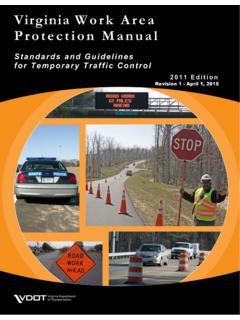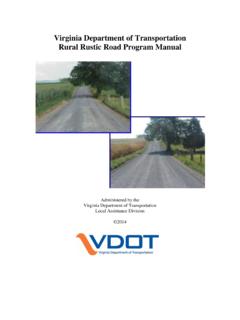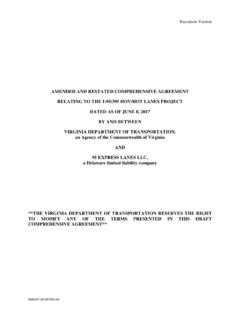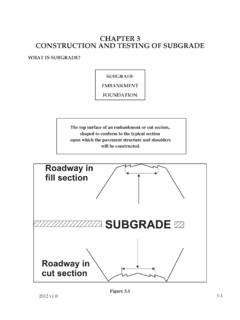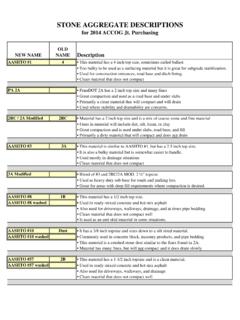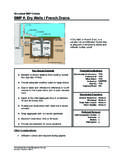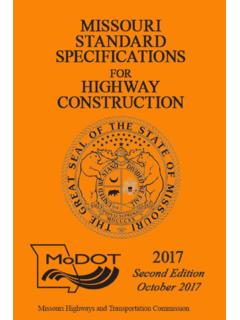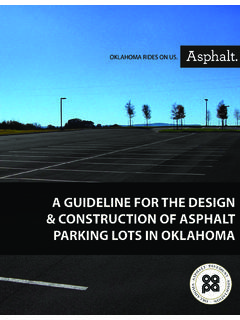Transcription of CONSTRUCTION AND ACCEPTANCE TESTING OF …
1 VDOT Soils and aggregate Compaction Chapter 3 | 1 3 CONSTRUCTION AND ACCEPTANCE TESTING OF SUBGRADE MATERIAL LEARNING OUTCOMES Understand the importance of subgrade and the different types of subgrade material Understand the various types and methods of mechanical and chemical stabilization Understand the compaction and TESTING requirements for various subgrade materials INTRODUCTION What is Subgrade? Subgrade is the top surface of an embankment or cut section that is shaped to conform to the typical section upon which the pavement structure and shoulders will be constructed. Figure : Typical Cross Section for Roadway Fill Section Figure : Typical Cross Section for Roadway Cut Section VDOT Soils and aggregate Compaction Chapter 3 | 2 Importance of Subgrade Heavy trucks and buses are continually loading our pavements.
2 These loads are transmitted through the pavement to the subgrade. In effect, the loads applied to the surface of the pavement are transmitted through the structure, deforming or otherwise destroying the integrity of the subgrade. How the subgrade is going to react under the application of traffic loads is of great concern. As illustrated in Figure , how the load gets transferred to the subgrade and how the subgrade can handle that load has a strong influence on the overall quality of the pavement. If the pavement is thin, as shown in the right hand sketch, the stress imposed by the traffic load through the pavement is distributed over a small area, making for high stresses on the subgrade. If the subgrade is poorly prepared (improper compaction, excessive moisture, etc.) or has a very low strength (such as with highly plastic clays), the subgrade cannot resist these high stresses and ruts will form, which could lead to significant damage to the pavement.
3 If the pavement is thick, as shown in the left hand sketch, the stress imposed by the traffic load through the pavement is distributed over a large area, making for low stresses on the subgrade. Even if the subgrade is made up of low strength soils, such as the highly plastic clays mentioned above, you can still have a good performing pavement because the stress projected through the pavement is lower than it would be with a thin pavement and if the design is done properly, these stresses should be lower than what can be resisted by the subgrade. It is still important to have the subgrade soils properly compacted when a thick pavement is used because rutting can still take place. As mentioned above, reducing stress can be accomplished by simply building a thicker pavement. This looks great on paper and is practical to a point. But pavement items are very expensive.
4 Optimizing the pavement itself is very important, but there comes a point where this is not practical. Providing a strong subgrade is essential. Increasing the strength of subgrade allows us to use a thinner pavement. California Bearing Ratio (CBR) test is run on soils to gauge the strength of the subgrade as compared to a dense graded aggregate . CBR is one of the major factors used in pavement design to determine how thick the pavement should be. Since we have chosen a pavement based on certain subgrade conditions, we must have the best subgrade conditions under our pavement for it to perform its job. Figure : Load Distribution Characteristics of Thick versus Thin Pavements VDOT Soils and aggregate Compaction Chapter 3 | 3 To understand the impact of CBR (subgrade strength) on the pavement, let s look at some typical CBR values.
5 A clayey soil generally has a low CBR value (less than 8). Sands are more granular and drain better and will generally have CBR values between 15 and 35. Gravel will have the best CBR values, generally 25 and up. That is why it is suggested to save the best material to cap the subgrade. The higher the CBR of foundation soils you have, the less pavement structure is needed, the more economical the design. CBR values are also used as criteria for borrow material. Types of Subgrade Material TABLE Type of Subgrade Material Material Type Material Description Material in Place Soil in a cut section of roadway Imported Material Borrow material and regular excavation material Treated Material Material in place or imported material May be considered in the design of the pavement structure Improves engineering properties of the soil Provides a solid platform to compact subsequent layers The specifications list three types of material which are acceptable for use as subgrade.
6 Each type has different characteristics and must be dealt with accordingly. Material in Place Whenever the roadway will be in a cut section, subgrade will be in original ground. The density of most soils is at approximately 85 to 90 percent of our Standard Proctor density (VTM 1 or VTM 12) in its natural state. Soil in this condition often falls short of having the strength to support our pavement structure. In order to achieve our desired strength, these soils must be compacted. The specifications require that material in place be scarified to a depth of 6 inches for a distance of 2 feet beyond the proposed edges of pavement on each side. This is illustrated in Figure on Page 3 5. This requirement applies to both cut and fill sections. Imported Material Subgrade material consisting of imported material is called borrow material.
7 This material can come from regular excavation from another area in the project, from commercial sources, or from local pits or quarries obtained by the Department or the Contractor. Placement and compaction of borrow material would follow the same procedures and practices that are used when placing and compacting soil taken from a cut site on the project. Treated Material in Place For some soils, simply scarifying and compacting will not produce the desired strength needed to support our pavement. In these cases it can be very cost effective to stabilize the subgrade with lime, cement, fly ash or a combination thereof. This provides a solid foundation for the remainder of the pavement. Stabilized subgrade provides two very important benefits: 1) Becomes part of the pavement structure 2) Improves the structural integrity of the layers placed above it VDOT Soils and aggregate Compaction Chapter 3 | 4 COMPACTION REQUIREMENTS FOR SUBGRADE Whether subgrade consists of material in place, treated material in place or imported material, it must be compacted to 100% density (95% for soil lime).
8 Field densities are compared to VTM 1 or VTM 12. VDOT requires 100% density because it promotes uniformity of subgrade and improves the strength of the subgrade. When subgrade material contains large quantities of material retained on the No. 4 sieve, use the table below to determine the minimum required density. TABLE Density Requirements for Subgrade Material Percent +4 Material Minimum % Density Required 0 50% 100% 51 60% 95% 61 70% 90% The moisture requirement for subgrade is optimum moisture 20%. In cut sections, the subgrade should be scarified and re compacted 2 feet beyond the edge of pavement and six inches deep. SUBGRADE STABILIZATION The top of subgrade, as with other portions of an embankment, can be stabilized by two primary methods: mechanical and chemical. Mechanical Stabilization In the case of mechanical stabilization, rolling (compaction) is the simplest and most commonly used method.
9 Appendix E details the various types of rollers available and which type roller works best for certain soils. For subgrade stabilization however, the most commonly used rollers are pneumatic, static steel wheel, and vibratory steel wheel. The benefits of rolling include increasing the material density and strength, along with decreasing its permeability and compressibility. 2 6 Figure : Typical Cross Section of Roadway Subgrade Requiring Scarification VDOT Soils and aggregate Compaction Chapter 3 | 5 Another method of mechanical stabilization is geosynthetics, which is gaining popularity throughout the commonwealth. The types of geosynthetics that are most likely used for stabilization are geotextiles, geogrids, and geocomposites.
10 Geotextiles consist of synthetic fibers made into flexible, porous fabrics by standard weaving machinery or are matted together in a random nonwoven manner. Geogrids plastics formed into open, gridlike configuration. Geocomposites a combination of Geosynthetics such as a Geotextile attached to a dimpled plastic sheet used for pavement drainage, or a Geotextile attached to a geogrid. Geotextiles have been used in roadway CONSTRUCTION in Virginia since the early 1970 s, primarily in erosion and siltation control. In the 1980 s, the CONSTRUCTION industry began using geosynthetics in earth stabilization applications. The primary benefit of using a geotextile is that you get separation between the poor quality subsoil and the better quality backfill material. An additional benefit of using a geotextile or a geogrid is an increased resistance to spreading by means of the reinforcement.
